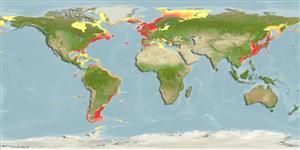Common names from other countries
Classification / Names / Names
Populaire namen | Synoniemen | Catalog of Fishes (gen., sp.) | ITIS | CoL | WoRMS
Environment: milieu / climate zone / depth range / distribution range
Ecologie
; brakwater; diepteverspreiding 0 - 590 m (Ref. 415). Tropical
Northwest Pacific, Atlantic Ocean, Mediterranean, Antarctic and Arctic Ocean: Iberian Peninsula and Belize. Tropical and subtropical.
Length at first maturity / Size / Gewicht / Leeftijd
Maturity: Lm ? range ? - ? cm Max length : 3.0 cm TL mannelijk/geslacht niet bekend; (Ref. 415)
Found in rock crevices, mangrove root mats and mud, along subtidal and intertidal zones in marine and brackish environments (Ref. 415). Known to be an osconformer, which is unaffected by large and repeated changes in salinity, but is known to be affected by increases in water temperature (Ref. 86624). Known as a benthic species (Ref. 85346). Intertidal to 590 m in rock crevices; mangrove roots mats and mud (Ref. 415); 34 to 500 m both in Ionian and North Aegean Sea (Ref. 775). Infaunal, burrows (Ref. 116123). This species is collected from mangrove and Thalassia root mats (Ref. 86591).
Collin, R., M.C. Díaz, J. Norenburg, R.M. Rocha, J.A. Sánchez, M. Schulze, A. Schwartz and A. Valdés. 2005. (Ref. 415)
Status op de Rode Lijst van het IUCN (Ref. 130435)
Status bij CITES (Ref. 108899)
Not Evaluated
Not Evaluated
Gebruik door de mens
| FishSource |
Tools
Meer informatie
Populaire namenSynoniemenPredatorsVoortplantingGeslachtsrijpheidKuitschietenFecundityEierenOntwikkeling van de eieren
Leeftijd/Grootte
Groei
Lengte-gewicht parameters
Lengte-lengte parameters
Morfologie
Larven
Abundantie
Internet-bronnen
Estimates based on models
Preferred temperature
(Ref.
115969): 3.4 - 22, mean 8.5 (based on 1568 cells).
Kwetsbaarheid
Low vulnerability (10 of 100).
Prijsklasse
Unknown.
